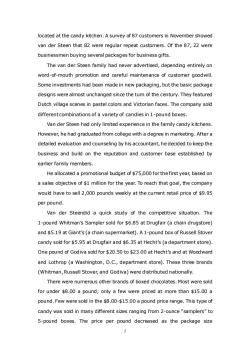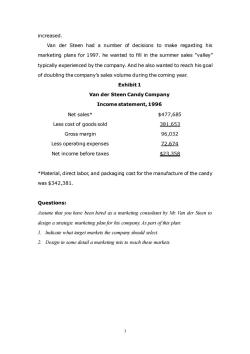《市场营销学》课程教学案例(双语)Van Der Steen Candy Company

Van Der Steen Candy Company Designing a Strategic Marketing Plan Joseph van der Steen had just inherited the family candy business in downtown Baltimore.Selling in limited volume to a select group of customers,his grandfather had built a loyal following among people who would pay a premium price for beautiful and authentically old-fashioned, hand-dipped chocolates.All ingredients were natural:real butter and chocolate,fresh-ground vanilla and other flavors,authentic maple sugar, and so on.All nutmeats were premium quality.Recipes and package designs were virtually unchanged since 1855,when the family had moved from Holland to Baltimore and begun selling candy. The candy kitchens and production facilities were located in an area near the center of downtown that had been unaffected by urban renewal.The building and equipment were sturdy,spotless,and in excellent condition, according to time-honored family traditions.The small staff was expert and loyal.Current production ran from 700 pounds weekly in July to a high of 1,200 pounds weekly in December.Capacity was estimated at 2,000 pounds per week,if one or two unskilled workers were added for packing,stock control,and cleaning duties.The van der Steens also owned a large building that backed up to the kitchen but it had fallen into disuse. The prices of van der Steen candy had held steady over the past couple years due to a decrease in the inflation rate.For several years prior to that, however,prices had to be raised annually to compensate for sharp jumps in the costs of sugar,chocolate,packaging materials,and other items. Even when prices were increased,demand remained stable.Sales for 1996 were $477,685 and pretax net profit was $23,358.An income statement for 1996 is shown in Exhibit 1. The company depended entirely on walk-in traffic at their retail store
1 Van Der Steen Candy Company Designing a Strategic Marketing Plan Joseph van der Steen had just inherited the family candy business in downtown Baltimore. Selling in limited volume to a select group of customers, his grandfather had built a loyal following among people who would pay a premium price for beautiful and authentically old-fashioned, hand-dipped chocolates. All ingredients were natural: real butter and chocolate, fresh-ground vanilla and other flavors, authentic maple sugar, and so on. All nutmeats were premium quality. Recipes and package designs were virtually unchanged since 1855, when the family had moved from Holland to Baltimore and begun selling candy. The candy kitchens and production facilities were located in an area near the center of downtown that had been unaffected by urban renewal. The building and equipment were sturdy, spotless, and in excellent condition, according to time-honored family traditions. The small staff was expert and loyal. Current production ran from 700 pounds weekly in July to a high of 1,200 pounds weekly in December. Capacity was estimated at 2,000 pounds per week, if one or two unskilled workers were added for packing, stock control, and cleaning duties. The van der Steens also owned a large building that backed up to the kitchen but it had fallen into disuse. The prices of van der Steen candy had held steady over the past couple years due to a decrease in the inflation rate. For several years prior to that, however, prices had to be raised annually to compensate for sharp jumps in the costs of sugar, chocolate, packaging materials, and other items. Even when prices were increased, demand remained stable. Sales for 1996 were $477,685 and pretax net profit was $23,358. An income statement for 1996 is shown in Exhibit 1. The company depended entirely on walk-in traffic at their retail store

located at the candy kitchen.A survey of 87 customers in November showed van der Steen that 82 were regular repeat customers.Of the 87,22 were businessmen buying several packages for business gifts. The van der Steen family had never advertised,depending entirely on word-of-mouth promotion and careful maintenance of customer goodwill. Some investments had been made in new packaging,but the basic package designs were almost unchanged since the tum of the century.They featured Dutch village scenes in pastel colors and Victorian faces.The company sold different combinations of a variety of candies in 1-pound boxes. Van der Steen had only limited experience in the family candy kitchens. However,he had graduated from college with a degree in marketing.After a detailed evaluation and counseling by his accountant,he decided to keep the business and build on the reputation and customer base established by earlier family members He allocated a promotional budget of $75,000 for thefirst year,based on a sales objective of $1 million for the year.To reach that goal,the company would have to sell 2,000 pounds weekly at the current retail price of $9.95 per pound. Van der Steendid a quick study of the competitive situation.The 1-pound Whitman's Sampler sold for $6.85 at Drugfair(a chain drugstore) and $5.19 at Giant's(a chain supermarket).A 1-pound box of Russell Stover candy sold for $5.95 at Drugfair and $6.35 at Hecht's(a department store) One pound of Godiva sold for$20.50 to $23.00 at Hecht's and at Woodward and Lothrop (a Washington,D.C.,department store).These three brands (Whitman,Russell Stover,and Godiva)were distributed nationally. There were numerous other brands of boxed chocolates.Most were sold for under $8.00 a pound;only a few were priced at more than $15.00 a pound.Few were sold in the $8.00-$15.00 a pound price range.This type of candy was sold in many different sizes ranging from 2-ounce"samplers"to 5-pound boxes.The price per pound decreased as the package size 2
2 located at the candy kitchen. A survey of 87 customers in November showed van der Steen that 82 were regular repeat customers. Of the 87, 22 were businessmen buying several packages for business gifts. The van der Steen family had never advertised, depending entirely on word-of-mouth promotion and careful maintenance of customer goodwill. Some investments had been made in new packaging, but the basic package designs were almost unchanged since the turn of the century. They featured Dutch village scenes in pastel colors and Victorian faces. The company sold different combinations of a variety of candies in 1-pound boxes. Van der Steen had only limited experience in the family candy kitchens. However, he had graduated from college with a degree in marketing. After a detailed evaluation and counseling by his accountant, he decided to keep the business and build on the reputation and customer base established by earlier family members. He allocated a promotional budget of $75,000 for the first year, based on a sales objective of $1 million for the year. To reach that goal, the company would have to sell 2,000 pounds weekly at the current retail price of $9.95 per pound. Van der Steendid a quick study of the competitive situation. The 1-pound Whitman’s Sampler sold for $6.85 at Drugfair (a chain drugstore) and $5.19 at Giant’s (a chain supermarket). A 1-pound box of Russell Stover candy sold for $5.95 at Drugfair and $6.35 at Hecht’s (a department store). One pound of Godiva sold for $20.50 to $23.00 at Hecht’s and at Woodward and Lothrop (a Washington, D.C., department store). These three brands (Whitman, Russell Stover, and Godiva) were distributed nationally. There were numerous other brands of boxed chocolates. Most were sold for under $8.00 a pound; only a few were priced at more than $15.00 a pound. Few were sold in the $8.00-$15.00 a pound price range. This type of candy was sold in many different sizes ranging from 2-ounce “samplers” to 5-pound boxes. The price per pound decreased as the package size

increased. Van der Steen had a number of decisions to make regarding his marketing plans for 1997.he wanted to fill in the summer sales "valley" typically experienced by the company.And he also wanted to reach his goal of doubling the company's sales volume during the coming year. Exhibit1 Van der Steen Candy Company Income statement,1996 Net sales* $477,685 Less cost of goods sold 381653 Gross margin 96,032 Less operating expenses 72674 Net income before taxes $23358 *Material,direct labor,and packaging cost for the manufacture of the candy was$342,381. Questions Assume that you have been hired as a marketing consultant by Mr Van der Steen to design a strategic marketing plan for his company.As part of this plan: 1.Indicate what target markets the company should select. 2.Design in some detail a marketing mix to reach these markets
3 increased. Van der Steen had a number of decisions to make regarding his marketing plans for 1997. he wanted to fill in the summer sales “valley” typically experienced by the company. And he also wanted to reach his goal of doubling the company’s sales volume during the coming year. Exhibit 1 Van der Steen Candy Company Income statement, 1996 Net sales* $477,685 Less cost of goods sold 381,653 Gross margin 96,032 Less operating expenses 72,674 Net income before taxes $23,358 *Material, direct labor, and packaging cost for the manufacture of the candy was $342,381. Questions: Assume that you have been hired as a marketing consultant by Mr. Van der Steen to design a strategic marketing plan for his company. As part of this plan: 1. Indicate what target markets the company should select. 2. Design in some detail a marketing mix to reach these markets
按次数下载不扣除下载券;
注册用户24小时内重复下载只扣除一次;
顺序:VIP每日次数-->可用次数-->下载券;
- 《市场营销学》课程教学案例(双语)The Pepsi and Coca-Cola Challenge-A Cola with Breakfast.doc
- 《市场营销学》课程教学案例(中文)第1章案例 营销与营销管理-亚马逊名震全球之道.doc
- 《市场营销学》课程教学案例(中文)第2章案例 规划企业战略与市场营销管理-雅戈尔,选择没有对错.doc
- 《市场营销学》课程教学案例(中文)第4章案例 分析消费者市场与购买行为-小阿华的“精确营销”.doc
- 《市场营销学》课程教学案例(中文)第3章案例 市场营销环境-恒伟药业信息调研出效益.doc
- 《市场营销学》课程教学案例(中文)第5章案例 市场细分、决定目标市场与定位- “红高粱”的启示.doc
- 《市场营销学》课程教学案例(中文)第7章案例 价格决策-海信空调的价格策略.doc
- 《市场营销学》课程教学案例(中文)第6章案例 产品决策-广东太阳神的产品组合.doc
- 《市场营销学》课程教学案例(中文)第9章案例 促销策略-中国肥皂泡戏煞东瀛人.doc
- 《市场营销学》课程教学案例(中文)第8章案例 分销渠道策略-通用公司打造全球供应链.doc
- 《市场营销学》课程授课教案(双语)Chapter 1 Marketing.doc
- 《市场营销学》课程授课教案(双语)Chapter 3 Analyzing the Marketing Environment.doc
- 《市场营销学》课程授课教案(双语)Chapter 5 Consumer Markets and Consumer Buyer Behavior.doc
- 《市场营销学》课程授课教案(双语)Chapter 4 Managing Marketing Information to Gain Customer Insights.doc
- 《市场营销学》课程授课教案(双语)Chapter 2 Company and Marketing Strategy.doc
- 《市场营销学》课程授课教案(双语)Chapter 11 Communicating Customer Value.doc
- 《市场营销学》课程授课教案(双语)Chapter 8 Products, Services, and Brands.doc
- 《市场营销学》课程授课教案(双语)Chapter 7 Customer-Driven Marketing Strategy.doc
- 《市场营销学》课程授课教案(双语)Chapter 6 Business Markets and Business Buyer Behavior.doc
- 《市场营销学》课程授课教案(双语)Chapter 9 Pricing and Pricing Strategies.doc
- 《市场营销学》课程教学案例(双语)Summit Ski Produc.doc
- 《市场营销学》课程教学案例(双语)Who will go to Saudi Arabia.doc
- 《市场营销学》课程教学案例(双语)Egle Steel Supply Company.doc
- 《市场营销学》课程教学案例(双语)Selling Whoppers In Japan.doc
- 内蒙古科技大学:《市场营销学》课程作业习题(分章)市场营销学练习及答案(共九章).doc
- 内蒙古科技大学:《市场营销学》课程作业习题(综合)综合习题九.doc
- 内蒙古科技大学:《市场营销学》课程作业习题(综合)综合习题九答案.doc
- 内蒙古科技大学:《市场营销学》课程作业习题(综合)综合习题十.doc
- 内蒙古科技大学:《市场营销学》课程作业习题(综合)综合习题十答案.doc
- 内蒙古科技大学:《市场营销学》课程作业习题(综合)综合习题八答案.doc
- 内蒙古科技大学:《市场营销学》课程作业习题(综合)综合习题七答案.doc
- 内蒙古科技大学:《市场营销学》课程作业习题(综合)综合习题八.doc
- 内蒙古科技大学:《市场营销学》课程作业习题(综合)综合习题七.doc
- 内蒙古科技大学:《市场营销学》课程作业习题(综合)综合习题六.doc
- 内蒙古科技大学:《市场营销学》课程作业习题(综合)综合习题六答案.doc
- 内蒙古科技大学:《市场营销学》课程作业习题(综合)综合习题五.doc
- 内蒙古科技大学:《市场营销学》课程作业习题(综合)综合习题五答案.doc
- 内蒙古科技大学:《市场营销学》课程作业习题(综合)综合习题四答案.doc
- 内蒙古科技大学:《市场营销学》课程作业习题(综合)综合习题四.doc
- 内蒙古科技大学:《市场营销学》课程作业习题(综合)综合习题三答案.doc
